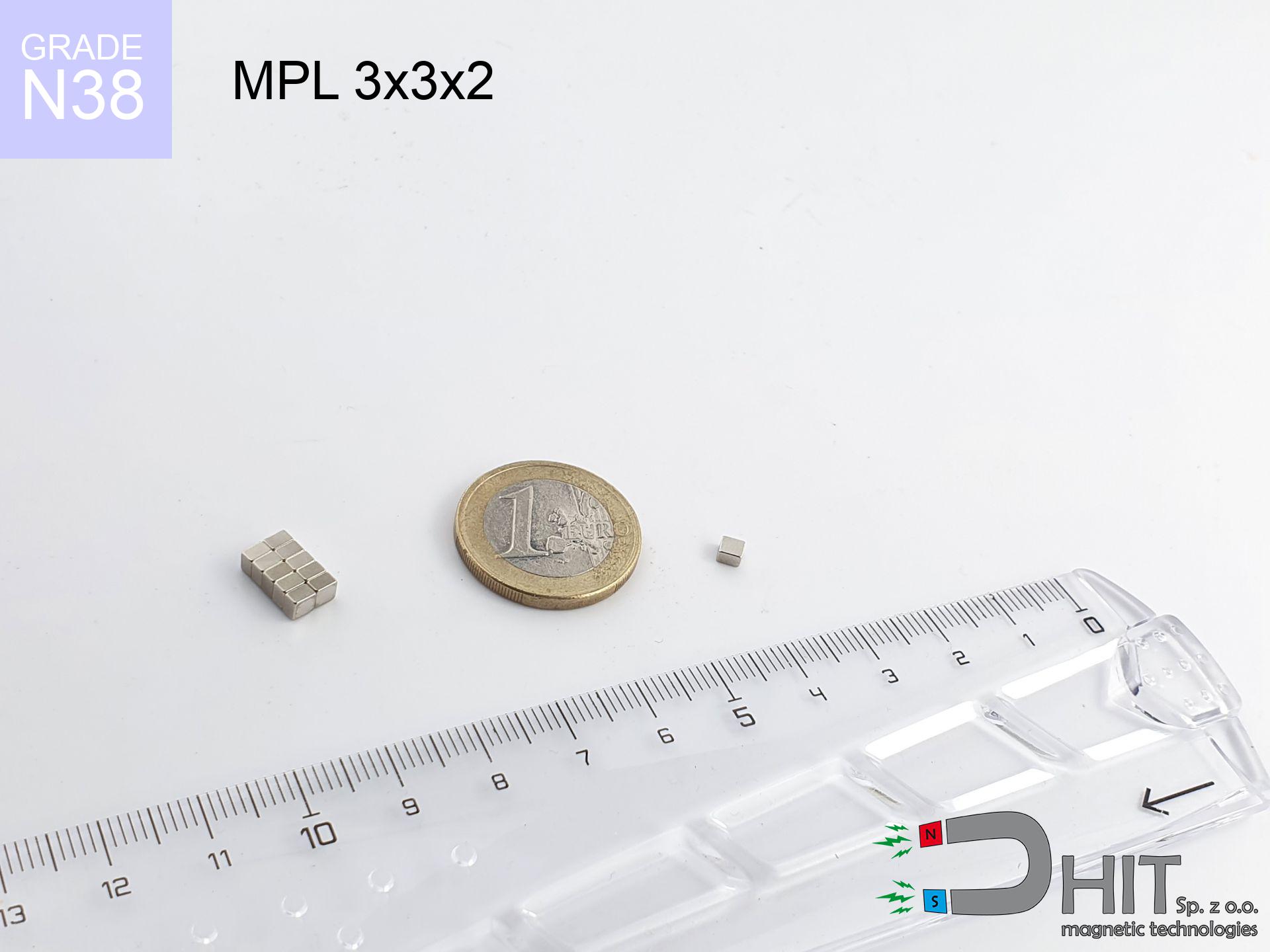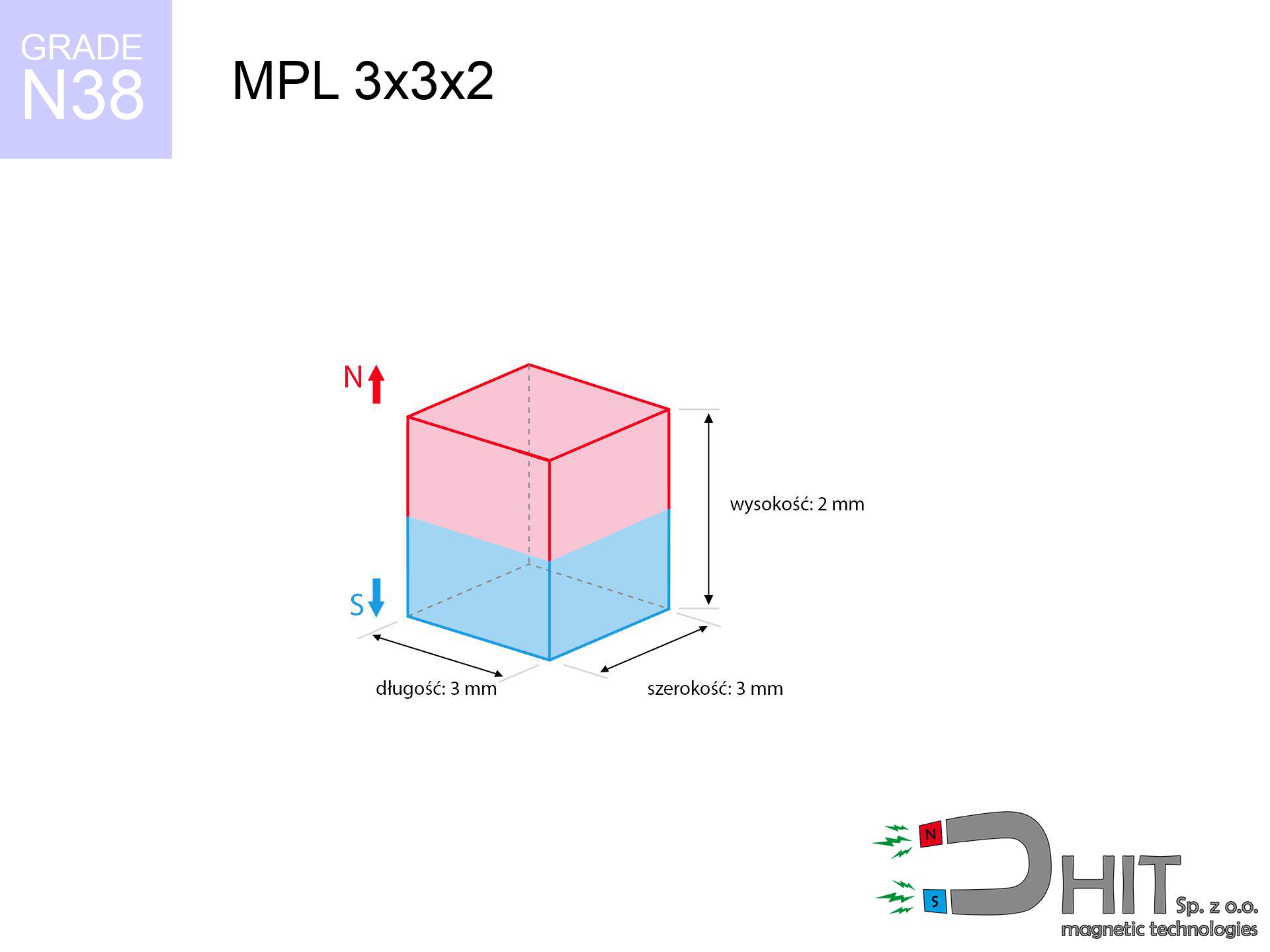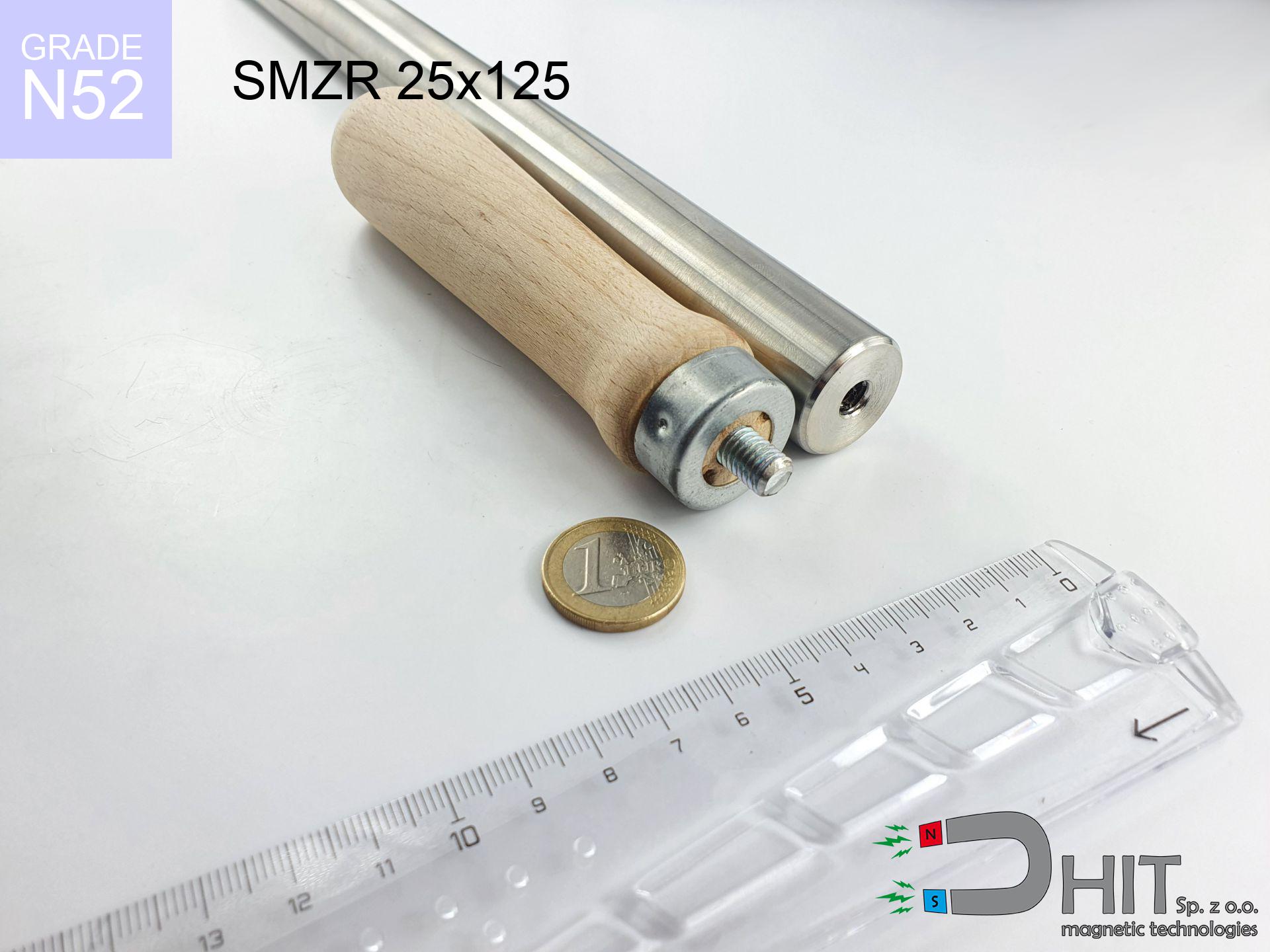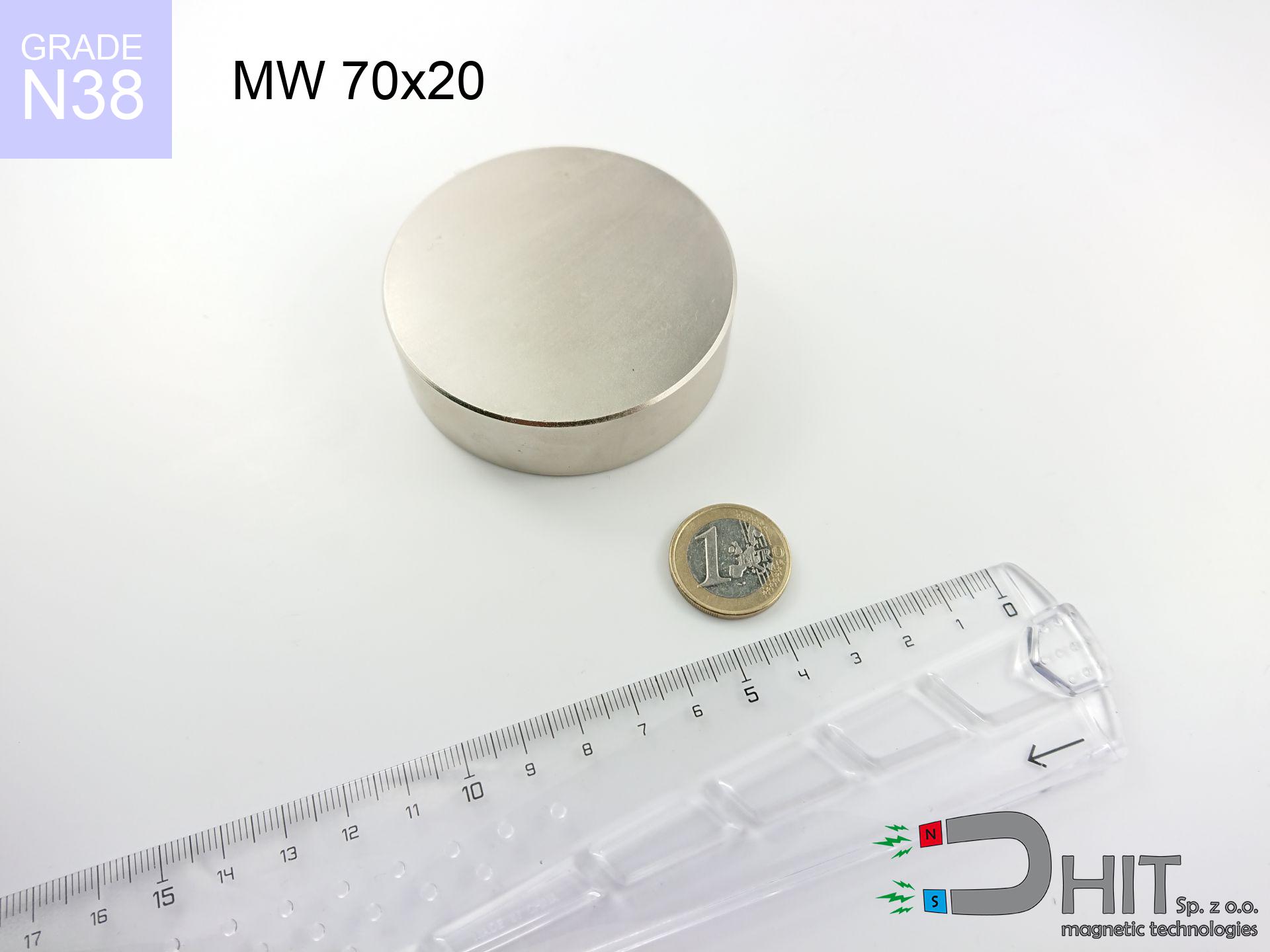MPL 3x3x2 / N38 - lamellar magnet
lamellar magnet
Catalog no 020147
GTIN/EAN: 5906301811534
length
3 mm [±0,1 mm]
Width
3 mm [±0,1 mm]
Height
2 mm [±0,1 mm]
Weight
0.13 g
Magnetization Direction
↑ axial
Load capacity
0.36 kg / 3.49 N
Magnetic Induction
472.94 mT / 4729 Gs
Coating
[NiCuNi] Nickel
0.1722 ZŁ with VAT / pcs + price for transport
0.1400 ZŁ net + 23% VAT / pcs
bulk discounts:
Need more?
Call us now
+48 22 499 98 98
otherwise get in touch using
request form
the contact section.
Lifting power along with form of neodymium magnets can be analyzed with our
online calculation tool.
Order by 14:00 and we’ll ship today!
Technical parameters - MPL 3x3x2 / N38 - lamellar magnet
Specification / characteristics - MPL 3x3x2 / N38 - lamellar magnet
| properties | values |
|---|---|
| Cat. no. | 020147 |
| GTIN/EAN | 5906301811534 |
| Production/Distribution | Dhit sp. z o.o. |
| Country of origin | Poland / China / Germany |
| Customs code | 85059029 |
| length | 3 mm [±0,1 mm] |
| Width | 3 mm [±0,1 mm] |
| Height | 2 mm [±0,1 mm] |
| Weight | 0.13 g |
| Magnetization Direction | ↑ axial |
| Load capacity ~ ? | 0.36 kg / 3.49 N |
| Magnetic Induction ~ ? | 472.94 mT / 4729 Gs |
| Coating | [NiCuNi] Nickel |
| Manufacturing Tolerance | ±0.1 mm |
Magnetic properties of material N38
| properties | values | units |
|---|---|---|
| remenance Br [min. - max.] ? | 12.2-12.6 | kGs |
| remenance Br [min. - max.] ? | 1220-1260 | mT |
| coercivity bHc ? | 10.8-11.5 | kOe |
| coercivity bHc ? | 860-915 | kA/m |
| actual internal force iHc | ≥ 12 | kOe |
| actual internal force iHc | ≥ 955 | kA/m |
| energy density [min. - max.] ? | 36-38 | BH max MGOe |
| energy density [min. - max.] ? | 287-303 | BH max KJ/m |
| max. temperature ? | ≤ 80 | °C |
Physical properties of sintered neodymium magnets Nd2Fe14B at 20°C
| properties | values | units |
|---|---|---|
| Vickers hardness | ≥550 | Hv |
| Density | ≥7.4 | g/cm3 |
| Curie Temperature TC | 312 - 380 | °C |
| Curie Temperature TF | 593 - 716 | °F |
| Specific resistance | 150 | μΩ⋅cm |
| Bending strength | 250 | MPa |
| Compressive strength | 1000~1100 | MPa |
| Thermal expansion parallel (∥) to orientation (M) | (3-4) x 10-6 | °C-1 |
| Thermal expansion perpendicular (⊥) to orientation (M) | -(1-3) x 10-6 | °C-1 |
| Young's modulus | 1.7 x 104 | kg/mm² |
Technical simulation of the magnet - technical parameters
The following values are the outcome of a physical simulation. Results are based on algorithms for the material Nd2Fe14B. Actual conditions might slightly deviate from the simulation results. Use these calculations as a preliminary roadmap during assembly planning.
Table 1: Static pull force (force vs gap) - interaction chart
MPL 3x3x2 / N38
| Distance (mm) | Induction (Gauss) / mT | Pull Force (kg) | Risk Status |
|---|---|---|---|
| 0 mm |
4719 Gs
471.9 mT
|
0.36 kg / 360.0 g
3.5 N
|
low risk |
| 1 mm |
2223 Gs
222.3 mT
|
0.08 kg / 79.9 g
0.8 N
|
low risk |
| 2 mm |
966 Gs
96.6 mT
|
0.02 kg / 15.1 g
0.1 N
|
low risk |
| 3 mm |
468 Gs
46.8 mT
|
0.00 kg / 3.5 g
0.0 N
|
low risk |
| 5 mm |
153 Gs
15.3 mT
|
0.00 kg / 0.4 g
0.0 N
|
low risk |
| 10 mm |
26 Gs
2.6 mT
|
0.00 kg / 0.0 g
0.0 N
|
low risk |
| 15 mm |
9 Gs
0.9 mT
|
0.00 kg / 0.0 g
0.0 N
|
low risk |
| 20 mm |
4 Gs
0.4 mT
|
0.00 kg / 0.0 g
0.0 N
|
low risk |
| 30 mm |
1 Gs
0.1 mT
|
0.00 kg / 0.0 g
0.0 N
|
low risk |
| 50 mm |
0 Gs
0.0 mT
|
0.00 kg / 0.0 g
0.0 N
|
low risk |
Table 2: Shear force (vertical surface)
MPL 3x3x2 / N38
| Distance (mm) | Friction coefficient | Pull Force (kg) |
|---|---|---|
| 0 mm | Stal (~0.2) |
0.07 kg / 72.0 g
0.7 N
|
| 1 mm | Stal (~0.2) |
0.02 kg / 16.0 g
0.2 N
|
| 2 mm | Stal (~0.2) |
0.00 kg / 4.0 g
0.0 N
|
| 3 mm | Stal (~0.2) |
0.00 kg / 0.0 g
0.0 N
|
| 5 mm | Stal (~0.2) |
0.00 kg / 0.0 g
0.0 N
|
| 10 mm | Stal (~0.2) |
0.00 kg / 0.0 g
0.0 N
|
| 15 mm | Stal (~0.2) |
0.00 kg / 0.0 g
0.0 N
|
| 20 mm | Stal (~0.2) |
0.00 kg / 0.0 g
0.0 N
|
| 30 mm | Stal (~0.2) |
0.00 kg / 0.0 g
0.0 N
|
| 50 mm | Stal (~0.2) |
0.00 kg / 0.0 g
0.0 N
|
Table 3: Vertical assembly (shearing) - behavior on slippery surfaces
MPL 3x3x2 / N38
| Surface type | Friction coefficient / % Mocy | Max load (kg) |
|---|---|---|
| Raw steel |
µ = 0.3
30% Nominalnej Siły
|
0.11 kg / 108.0 g
1.1 N
|
| Painted steel (standard) |
µ = 0.2
20% Nominalnej Siły
|
0.07 kg / 72.0 g
0.7 N
|
| Oily/slippery steel |
µ = 0.1
10% Nominalnej Siły
|
0.04 kg / 36.0 g
0.4 N
|
| Magnet with anti-slip rubber |
µ = 0.5
50% Nominalnej Siły
|
0.18 kg / 180.0 g
1.8 N
|
Table 4: Material efficiency (saturation) - sheet metal selection
MPL 3x3x2 / N38
| Steel thickness (mm) | % power | Real pull force (kg) |
|---|---|---|
| 0.5 mm |
|
0.04 kg / 36.0 g
0.4 N
|
| 1 mm |
|
0.09 kg / 90.0 g
0.9 N
|
| 2 mm |
|
0.18 kg / 180.0 g
1.8 N
|
| 5 mm |
|
0.36 kg / 360.0 g
3.5 N
|
| 10 mm |
|
0.36 kg / 360.0 g
3.5 N
|
Table 5: Thermal stability (stability) - resistance threshold
MPL 3x3x2 / N38
| Ambient temp. (°C) | Power loss | Remaining pull | Status |
|---|---|---|---|
| 20 °C | 0.0% |
0.36 kg / 360.0 g
3.5 N
|
OK |
| 40 °C | -2.2% |
0.35 kg / 352.1 g
3.5 N
|
OK |
| 60 °C | -4.4% |
0.34 kg / 344.2 g
3.4 N
|
OK |
| 80 °C | -6.6% |
0.34 kg / 336.2 g
3.3 N
|
|
| 100 °C | -28.8% |
0.26 kg / 256.3 g
2.5 N
|
Table 6: Two magnets (repulsion) - field collision
MPL 3x3x2 / N38
| Gap (mm) | Attraction (kg) (N-S) | Repulsion (kg) (N-N) |
|---|---|---|
| 0 mm |
1.24 kg / 1236 g
12.1 N
5 677 Gs
|
N/A |
| 1 mm |
0.63 kg / 627 g
6.2 N
6 725 Gs
|
0.56 kg / 565 g
5.5 N
~0 Gs
|
| 2 mm |
0.27 kg / 274 g
2.7 N
4 447 Gs
|
0.25 kg / 247 g
2.4 N
~0 Gs
|
| 3 mm |
0.12 kg / 117 g
1.1 N
2 903 Gs
|
0.11 kg / 105 g
1.0 N
~0 Gs
|
| 5 mm |
0.02 kg / 24 g
0.2 N
1 324 Gs
|
0.02 kg / 22 g
0.2 N
~0 Gs
|
| 10 mm |
0.00 kg / 1 g
0.0 N
306 Gs
|
0.00 kg / 0 g
0.0 N
~0 Gs
|
| 20 mm |
0.00 kg / 0 g
0.0 N
52 Gs
|
0.00 kg / 0 g
0.0 N
~0 Gs
|
| 50 mm |
0.00 kg / 0 g
0.0 N
4 Gs
|
0.00 kg / 0 g
0.0 N
~0 Gs
|
Table 7: Hazards (electronics) - precautionary measures
MPL 3x3x2 / N38
| Object / Device | Limit (Gauss) / mT | Safe distance |
|---|---|---|
| Pacemaker | 5 Gs (0.5 mT) | 2.0 cm |
| Hearing aid | 10 Gs (1.0 mT) | 1.5 cm |
| Timepiece | 20 Gs (2.0 mT) | 1.5 cm |
| Mobile device | 40 Gs (4.0 mT) | 1.0 cm |
| Remote | 50 Gs (5.0 mT) | 1.0 cm |
| Payment card | 400 Gs (40.0 mT) | 0.5 cm |
| HDD hard drive | 600 Gs (60.0 mT) | 0.5 cm |
Table 8: Impact energy (cracking risk) - warning
MPL 3x3x2 / N38
| Start from (mm) | Speed (km/h) | Energy (J) | Predicted outcome |
|---|---|---|---|
| 10 mm |
53.07 km/h
(14.74 m/s)
|
0.01 J | |
| 30 mm |
91.92 km/h
(25.53 m/s)
|
0.04 J | |
| 50 mm |
118.67 km/h
(32.96 m/s)
|
0.07 J | |
| 100 mm |
167.83 km/h
(46.62 m/s)
|
0.14 J |
Table 9: Corrosion resistance
MPL 3x3x2 / N38
| Technical parameter | Value / Description |
|---|---|
| Coating type | [NiCuNi] Nickel |
| Layer structure | Nickel - Copper - Nickel |
| Layer thickness | 10-20 µm |
| Salt spray test (SST) ? | 24 h |
| Recommended environment | Indoors only (dry) |
Table 10: Construction data (Pc)
MPL 3x3x2 / N38
| Parameter | Value | SI Unit / Description |
|---|---|---|
| Magnetic Flux | 429 Mx | 4.3 µWb |
| Pc Coefficient | 0.66 | High (Stable) |
Table 11: Underwater work (magnet fishing)
MPL 3x3x2 / N38
| Environment | Effective steel pull | Effect |
|---|---|---|
| Air (land) | 0.36 kg | Standard |
| Water (riverbed) |
0.41 kg
(+0.05 kg Buoyancy gain)
|
+14.5% |
1. Wall mount (shear)
*Note: On a vertical wall, the magnet holds only a fraction of its max power.
2. Plate thickness effect
*Thin metal sheet (e.g. computer case) significantly weakens the holding force.
3. Thermal stability
*For standard magnets, the critical limit is 80°C.
4. Demagnetization curve and operating point (B-H)
chart generated for the permeance coefficient Pc (Permeance Coefficient) = 0.66
This simulation demonstrates the magnetic stability of the selected magnet under specific geometric conditions. The solid red line represents the demagnetization curve (material potential), while the dashed blue line is the load line based on the magnet's geometry. The Pc (Permeance Coefficient), also known as the load line slope, is a dimensionless value that describes the relationship between the magnet's shape and its magnetic stability. The intersection of these two lines (the black dot) is the operating point — it determines the actual magnetic flux density generated by the magnet in this specific configuration. A higher Pc value means the magnet is more 'slender' (tall relative to its area), resulting in a higher operating point and better resistance to irreversible demagnetization caused by external fields or temperature. A value of 0.42 is relatively low (typical for flat magnets), meaning the operating point is closer to the 'knee' of the curve — caution is advised when operating at temperatures near the maximum limit to avoid strength loss.
Elemental analysis
| iron (Fe) | 64% – 68% |
| neodymium (Nd) | 29% – 32% |
| boron (B) | 1.1% – 1.2% |
| dysprosium (Dy) | 0.5% – 2.0% |
| coating (Ni-Cu-Ni) | < 0.05% |
Environmental data
| recyclability (EoL) | 100% |
| recycled raw materials | ~10% (pre-cons) |
| carbon footprint | low / zredukowany |
| waste code (EWC) | 16 02 16 |
See more products
Strengths as well as weaknesses of rare earth magnets.
Strengths
- They do not lose magnetism, even over nearly 10 years – the decrease in power is only ~1% (based on measurements),
- They retain their magnetic properties even under external field action,
- In other words, due to the shiny surface of silver, the element is aesthetically pleasing,
- Neodymium magnets ensure maximum magnetic induction on a contact point, which ensures high operational effectiveness,
- Due to their durability and thermal resistance, neodymium magnets can operate (depending on the shape) even at high temperatures reaching 230°C or more...
- Possibility of individual modeling and modifying to defined needs,
- Key role in modern industrial fields – they are used in computer drives, electric motors, medical devices, and multitasking production systems.
- Thanks to concentrated force, small magnets offer high operating force, occupying minimum space,
Limitations
- They are prone to damage upon heavy impacts. To avoid cracks, it is worth protecting magnets in special housings. Such protection not only shields the magnet but also improves its resistance to damage
- Neodymium magnets lose force when exposed to high temperatures. After reaching 80°C, many of them experience permanent weakening of power (a factor is the shape and dimensions of the magnet). We offer magnets specially adapted to work at temperatures up to 230°C marked [AH], which are extremely resistant to heat
- When exposed to humidity, magnets start to rust. For applications outside, it is recommended to use protective magnets, such as those in rubber or plastics, which secure oxidation as well as corrosion.
- Limited ability of creating threads in the magnet and complex forms - recommended is a housing - mounting mechanism.
- Potential hazard to health – tiny shards of magnets pose a threat, if swallowed, which is particularly important in the context of child health protection. Additionally, small elements of these magnets can be problematic in diagnostics medical after entering the body.
- Higher cost of purchase is a significant factor to consider compared to ceramic magnets, especially in budget applications
Lifting parameters
Highest magnetic holding force – what contributes to it?
- using a sheet made of low-carbon steel, serving as a magnetic yoke
- with a thickness no less than 10 mm
- with a plane perfectly flat
- under conditions of ideal adhesion (metal-to-metal)
- under vertical force vector (90-degree angle)
- in neutral thermal conditions
Lifting capacity in real conditions – factors
- Clearance – the presence of foreign body (rust, tape, gap) interrupts the magnetic circuit, which reduces capacity rapidly (even by 50% at 0.5 mm).
- Loading method – catalog parameter refers to pulling vertically. When applying parallel force, the magnet exhibits much less (often approx. 20-30% of maximum force).
- Wall thickness – thin material does not allow full use of the magnet. Part of the magnetic field passes through the material instead of converting into lifting capacity.
- Metal type – not every steel attracts identically. High carbon content worsen the attraction effect.
- Surface finish – ideal contact is obtained only on polished steel. Any scratches and bumps create air cushions, weakening the magnet.
- Thermal environment – heating the magnet causes a temporary drop of induction. It is worth remembering the maximum operating temperature for a given model.
Holding force was measured on a smooth steel plate of 20 mm thickness, when a perpendicular force was applied, however under attempts to slide the magnet the load capacity is reduced by as much as 75%. In addition, even a small distance between the magnet’s surface and the plate decreases the lifting capacity.
Safety rules for work with NdFeB magnets
Implant safety
Life threat: Neodymium magnets can turn off pacemakers and defibrillators. Stay away if you have electronic implants.
Physical harm
Risk of injury: The attraction force is so immense that it can result in hematomas, pinching, and broken bones. Protective gloves are recommended.
Beware of splinters
Neodymium magnets are ceramic materials, which means they are prone to chipping. Impact of two magnets will cause them breaking into small pieces.
Fire warning
Mechanical processing of neodymium magnets poses a fire risk. Neodymium dust oxidizes rapidly with oxygen and is difficult to extinguish.
Immense force
Before starting, check safety instructions. Sudden snapping can break the magnet or injure your hand. Think ahead.
Heat warning
Do not overheat. NdFeB magnets are sensitive to heat. If you need resistance above 80°C, look for HT versions (H, SH, UH).
Electronic devices
Device Safety: Strong magnets can ruin data carriers and delicate electronics (heart implants, medical aids, mechanical watches).
Impact on smartphones
Note: rare earth magnets produce a field that confuses precision electronics. Keep a separation from your phone, tablet, and GPS.
Skin irritation risks
Medical facts indicate that the nickel plating (standard magnet coating) is a common allergen. If you have an allergy, refrain from touching magnets with bare hands or choose encased magnets.
Danger to the youngest
NdFeB magnets are not toys. Swallowing multiple magnets can lead to them pinching intestinal walls, which constitutes a severe health hazard and necessitates immediate surgery.









